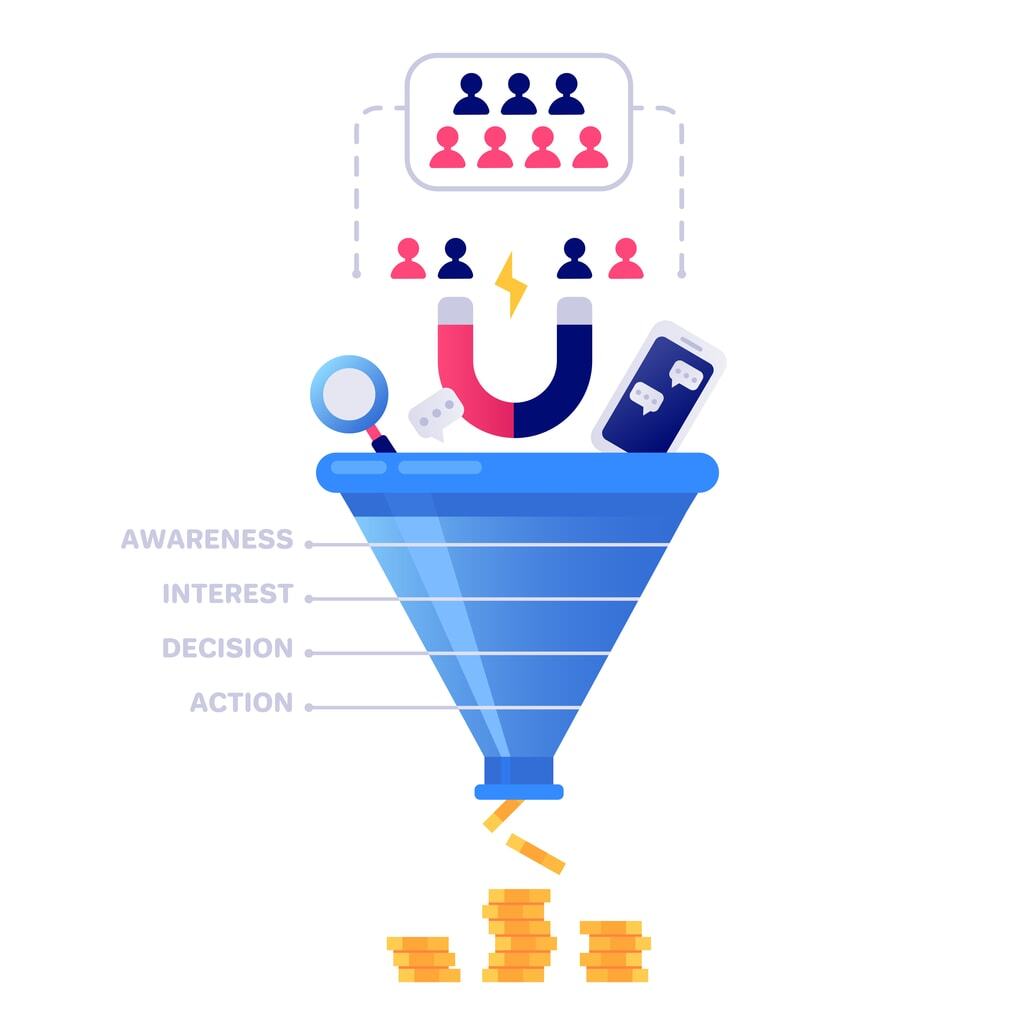What is a Value Ladder? The Basics.
The Value Ladder is a brilliant marketing strategy for selling products and services whether you have your own business or you market someone else's company. It works by offering discounts on low-ticket (relatively low cost), entry-level items to entice clients, after which you can start to introduce higher-priced and premium products as they become more convinced of your brand's value for money. Fundamentally, a value ladder is a marketing technique that allows you to increase the value of your products or services to provide more benefits for your customer. The strategy focuses on creating an emotional connection between the consumer and product so they will be more inclined to purchase regularly. The value ladder template is a tactic that has been around for decades but few business owners understand exactly how to implement it or why they should be doing so in the first place. A value ladder is important because you'll build more trust, retain customers longer, and generate more revenue by strategically implementing it into your overall marketing strategy for both new and existing customers alike. The concept might sound simple but mastering this basic idea can make all the difference in increasing or retaining what you currently have if you can successfully execute and utilize it. The use of a well designed value ladder combined with a well-thought-out sales funnel can truly ramp up your business sales. This article will teach you how to skyrocket your company's success by mastering one simple concept: value ladders. When this approach is mastered, it will help you take your business to new heights!
Benefits of a Value Ladder
A value ladder is a system you need to have in place to keep up with your competitors and ensure value in the business for your customers. Here are important benefits of having a value ladder system for your business: • It helps you keep up with the increasing competition, especially if it’s a prestigious industry where the price isn’t always something customers will think about. • People can see the value of what they are buying from your business, which is especially important for service based businesses that sell intangible things such as consulting or advice because it’s hard to measure value when there isn’t a physical product involved. It encourages loyalty. Customers value being valued, so if you take the time to show your them how much they mean to you then it makes them want to stay with you.
• It is crucial for customer retention, especially when there are lots of businesses that offer similar products or services at different price points. • It allows customers to see the value of your product and make an informed decision before they commit. • It helps attract new customers who are looking for value in the market, as well as incentivizing your existing customer base to spend more money with you. • It is a great way to attract new customers and potential clients. • It extends the lifetime value of a product or service by providing a series of up-sells or cross-sells. Customers will purchase a product and then utilize it for a set length of time before being inspired to upgrade their version to access additional features and advantages. Good value in business can be hard to come by. People are always looking for the best value when purchasing things, but it’s not just products that have value - your customers want high value and their money's worth too, and if you don’t provide them with this then they will go elsewhere.

The 4 Steps of a Value Ladder
The value ladder is a road map that should be followed during the whole customer journey, as well as at various points along with it. There are many metrics and KPIs value-oriented marketers constantly measure. They don't only consider first-time customers but also previous users who want to upgrade or explore other options. The following are the four steps and components of a value ladder template. • Awareness: To create a value ladder, you should start at the very beginning, which is getting your business known. This might be anything from a social media ad campaign to traditional print advertisements such as magazines and newspapers. It may also include activities that you wouldn't normally associate with advertising such as handing out discount coupons at a local fair booth. You have to get your potential customers interested in what you are offering so that they will pay attention when it comes time for them to purchase something from you. You need to convince them that they should buy from you rather than from someone else by clearly stating the value proposition (what's in it for me?) behind your product or service. • Interest: The value ladder continues by evoking interest, also known as the "hook" that will get people to move from awareness up a step on your value ladder and become interested in learning more about what you have to offer. A hook is meant to capture their attention and pique their desire for further information. This can include talking with salespeople or an email campaign where important information is provided right away to potential customers who sign up for news and updates on various items they may be interested in buying. The key to a value ladder is to make sure you are always offering something of value at each step, which will help your customers move up the value ladder. • Desire: This implies providing more features that may be added to an existing version of your product or service to entice customers who are seeking higher quality and value before purchasing now rather than waiting until later when perhaps even greater improvements will be made available. The goal here should be to turn prospects into loyal customers. This is the value ladder’s "payoff" stage, where you provide enough value for your paying customer to feel that it's worth their money and time to keep buying from you. • Action: This is when it all boils down to ensuring that those who buy from you are happy with what they get as well as how things proceed (i.e., through email vs. the post office; the speed of reaction time when there's a problem that demands attention, etc.). As a result, good word-of-mouth results in more consumers signing up. This step can also help businesses increase their profits by up-selling and cross-selling. Retain customers by simply providing them with a value ladder that is high in value. You can provide your customer services after they make a purchase or offer discounts if they plan on purchasing the product again to keep their loyalty and trust intact. Remember, having a great value ladder system will increase profits by encouraging customers to stay loyal and make recurring purchases rather than just one-time sales.

How do I Create a Value Ladder for my Business, Products, and Services?
A value ladder in business can be used by any type of company or organisation interested in growing its value proposition. Value ladders are best employed by online business and enterprises, especially those with sales funnels who can benefit the most from value ladders because they let you establish pricing for various levels of customer engagement on your website or service portfolio so that they make sense financially from top-to-bottom. It's critical to understand how you may use the value ladder approach to enhance your products and services to sell more. To begin with, all you need is a product or service that has more than one version. It might be an e-book, for example; it could also be membership on a website where tutorials are accessible, etc. It's all about meeting the customer where they are on their journey to becoming a dedicated supporter and lifetime customer of your business. The process goes like this: first, you provide them a free offer with something useful in exchange for nothing; then, as more people utilize your service and see how much better things can be, raise prices just enough so that only devoted users with spending power pay full price every time around, while everyone else gets exactly what they want without having asked too many questions or demanding anything different from you than before. The key here is finding an entry-level product or service, usually with a low cost. The next thing is choosing which of these products should come first in the series (the foundation). This means that when somebody purchases this item they'll like what they get because it provides them with some sort of value but not everything at once so there is something else left to purchase later down the line at various price points if they want to receive even more value.
Value Ladder in Business Examples:
• Ferrari: luxury car brand offering increasing value at different levels, starting with the Ferrari California T line which has lower prices than previous models but still offers many benefits that are attractive to their target market. • Nespresso: value ladder for a coffee brand that allows customers to spend more money on extra services and equipment, while still offering value in the form of quality drinks. • Rolex: luxury watchmaker who offers value ladders with different price points from entry-level all the way up to Rolex’s most expensive and premium product lines. • Adobe Photoshop: offers various versions including basic (starting at $19.99) to professional ($399) where each version is designed to appeal to customers at a certain degree of knowledge and interest evaluation purchase so you can see how they intend to gather their user base from novice to expert levels throughout each stage on the value ladder. As you can see, the best value ladders in successful businesses are a great way to attract new customers and keep your existing ones happy. The value ladder model is an effective method of not just increasing customer value but also maintaining lifetime customer value while still maintaining competitive prices.
Why Would You Want a Value Ladder?
A value ladder is a great way to increase profits and keep your customers happy. Maybe they're not purchasing from you because their expenses outweigh the benefits of doing so, but with the value ladder, you can give them something more valuable than what was originally purchased - which should be enough incentive! Give people an offer on your highest priced product or services for even higher prices if necessary (and make sure it's worth spending!). This will make it easy for them to get more out of your business, which means more profit potential for you! A value ladder is a great way to help customers find the best deals. You can set your prices at different levels so that people who are just starting out or might not know as much about these products will be able to get started with one at a great price deal. Customer loyalty is everything. It's the best way to sell your services and products because people will always go back if you give them what they want- but it also has risks attached. Someone else could take up where you leave off by trying even harder than before without success, so make sure not just that they're satisfied with their purchase, but talk about how great those little extras are too!

How Does a Value Ladder Affect Your Business?
Simply put, a value ladder can be used to increase your business profits through a step-by-step process that leads customers up the “ladder” towards purchasing your product or service by gaining their trust and loyalty one “rung” at a time. Your business success is driven by customer value. Make sure you're not leaving any money on the table and provide your clients with what they need most: a product or service that meets their needs, speaks to them in an authentic way (not trying too hard), and leaves behind satisfied customers who will refer others as well! Having a value ladder model is an easy way for you and your business to increase both the quality of service as well as revenue. The best part about it, though is how much value each customer will receive from whatever product or service they purchase at any point on this ladder.
The Perfect Value Ladder Structure
A value ladder is a strategy for growth. To succeed, it must be consistent with your brand and beliefs - never succumb to pressure from other businesses just because they have done so! A key part of maintaining what makes YOU great as an entrepreneur will come down to how well you execute on this plan; remember everyone needs help sometimes but do everything in your power not join them by being stagnant or going backward instead strive forward every day towards success. For some, success is all about how high you climb. For others, it's a matter of where your starting point was and if there were enough opportunities along the way for betterment or stagnation. To build an effective value ladder structure with clear price points at which prospective clients will purchase from you in droves without hesitation—first accepting lower offers as bait before upgrading when needed—the staging needs careful planning so buyers don't see any inconsistency between what they're paying now versus later on upfront during early negotiations stages. Then, once they took your low tier offer and that you delivered great value, it's time to promote your high-ticket digital marketing plans. Pro tip: no matter which service or product they go with, always overdeliver!

With Value Ladders, Help Your Clients Go Further, Faster, and Deeper
Think about it this way: People come to you for the bottom rung of your ladder. They pay well and they're easy to take care of, but there's not much room at that level. They need to climb up a step, and in order for them to do that, you have to give them something more. A value ladder is the process of giving your clients an opportunity to advance from one level of service or product purchase to another by making each successive purchase higher in price and greater in perceived value than those below it. The idea of a value ladder is to give your clients an opportunity for advancement. You start with the bottom and work up, giving them higher priced items than what they currently have or purchase from someone else in order make each successive purchase greater than those below it on our rung system that keeps people climbing upward without ever really reaching its top because there's always another step left! The time has come for you to take action and start building your own value ladder and bring your business model to new heights. You can offer increased levels of service (more detail, time, and attention), support (accessibility and convenience), features or benefits - whichever one is most appropriate in the eyes of customers! While effective marketing requires ongoing sales efforts, be careful not over-promote - there's nothing worse than offering too much at prices no one will pay!
Some Helpful Tips About Value Ladders
• Your value ladder should be flexible but consistent. • Be sure everyone on your team (Not only your sales team) knows how value ladders work. • Keep your value ladder simple by offering one big benefit per step, rather than several small ones. • Pay attention to what other businesses are doing with value ladders and learn from them.





1 Comment
everything we do is always has a key in order to be more effective thank you for sharing this value ladder. Godbless.